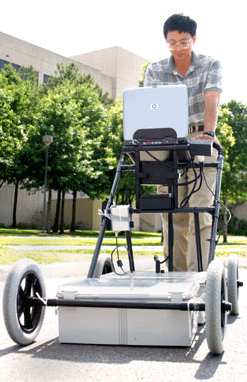When a construction crew pours concrete for an interstate highway, they're supposed to lay it on thick -- 15 inches thick, to be precise.
It's the responsibility of the Texas Department of Transportation (TXDoT) to make sure every highway meets the proper construction standards. But engineers with the state agency faced a tough problem: Once the road is constructed, how do you check the thickness of the concrete?
In the past, checking the thickness typically required drilling a core sample, which is time-consuming and costly. Now, thanks to the ingenuity of University of Houston Engineering Professor Richard Liu, the task can be completed without so much as scratching the road surface. Liu's work is enabling TXDoT to forego the drilling process in favor of rolling a device down the highway that can read the thickness of the concrete beneath, as well as other key facts, such as moisture level.
"Every lane mile of interstate highway is a $6 million project, so monitoring the thickness used by contractors is very important," says Liu, associate professor of electrical engineering. "TXDoT engineers usually take a core reading, they drill a core sample every 1,000 feet to make sure it's 15-inch pavement. They have to test it; otherwise they cannot be sure that the pavement is a good pavement."
Each core sample takes between 30 minutes and an hour to drill, at cost of about $700 per core, says Liu. A few years ago, TXDoT engineers approached Liu, asking him to develop a non-destructive device. In response, he developed a ground-penetrating reader, or GPR.
"They can use this system to measure the thickness of the pavement, as well as the moisture, which can help determine when a section of highway is ready to sustain traffic," he says. "There are many GPRs available. However, our device can directly measure the thickness automatically without human interference."
The GPR project is one of five nominated for the 2003 Most Innovative Research Award by the Texas Department of Transportation. Liu's chances of winning are higher than the other nominees: he has two projects nominated. The winning project will be announced at the TXDoT Research Management Conference in June.
When comparing between the drill core measurement and the GPR measurement, the difference is less than a quarter of an inch. TXDoT considers any measurement within a quarter of an inch of the sample to be accurate, Liu says.
"We can measure any distance," Liu says. "In this case, every seven feet we measured one core. Our equipment costs less than $5,000 to manufacture, but the cost of operating the GPR is very minimal and provides many times more data than drilling. It's their intention at TXDoT to use our device to measure and drill core only when they find discrepancies."
The entire device is made from original technology developed at the Cullen College of Engineering, says Liu. "We developed everything, from beginning to end, including hardware, software, high-frequency antennae, and design," says Liu. "There's nothing actually purchased from a commercial site. We designed and manufactured all the electronics right here at the university. It's the result of two Ph.D. dissertations and one master's thesis."
Now that the GPR has been successfully developed and tested, a new project will be launched to put the new devices into service all across Texas.
"The first GPR project, a pilot project, was funded at about $120,000. The next phase will be to build more units for implementation and will be funded at about $500,000," Liu says.
"No one else has ever done this," says Liu, who joined the UH faculty in 1992.
Liu says drilling will continue to play a pivotal role, especially when discrepancies result in litigation because only a core measurement is permissible as evidence in court.
The other project being considered for the most innovative award is one that detects the texture of the road surface with laser sensor technology developed by Liu and his students.
If the texture of a highway becomes too smooth, then the braking distance becomes too long and the chances of an accident increase. In the past, TXDoT has had no reliable way to measure the texture of road surfaces.
